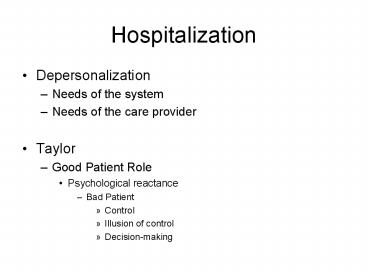Hospitalization - PowerPoint PPT Presentation
1 / 10
Title:
Hospitalization
Description:
Both doctor &patient are highly invested in patient outcomes, and are actively ... Narrowly biomedical: Interaction in which doctor spends most of the time asking ... – PowerPoint PPT presentation
Number of Views:172
Avg rating:3.0/5.0
Title: Hospitalization
1
Hospitalization
- Depersonalization
- Needs of the system
- Needs of the care provider
- Taylor
- Good Patient Role
- Psychological reactance
- Bad Patient
- Control
- Illusion of control
- Decision-making
2
Stress and Surgery
- Janis (1958)
- Interviewed patients presurgery, classifying
them - Extreme fear
- Moderate fear
- No fear
- Who showed fewest postoperative problems?
3
Stress and Surgery
- 3 basic types of information may be given to
patients awaiting surgery - Sensory
- Procedural
- Coping
- Are they equally useful?
4
Models of the Physician-Patient Relationship
- Active-Passive Model
- patient is unable (due to medical condition) to
participate in care and to make decisions
regarding personal welfare - Guidance-Cooperation Model
- physician assumes the majority of responsibility
for diagnosis/treatment - Pt answers questions that are asked but leaves
the thinking/decisions to the MD
5
Models of the Physician-Patient Relationship
- Mutual Participation Model
- MD Pt make joint decisions about every aspect
of care - Represents the most effective physician-patient
interchange that can occur - Each brings his/her own point of view to the task
of improving patients health
6
Models of the Physician-Patient Relationship
- Szasz Hollender (1956)
- Active-Passive Model
- Guidance-Cooperation Model
- Mutual Participation Model
Roter Hall (1992) Paternalism Consumerism De
fault
Mutuality
Roter, Stewart, Putman, Lipkin, Stiles, Inui
(1997) Narrowly Biomedical Expanded Biomedical
Biopsychosocial Psychosocial Consumerist
Ballard-Reisch (1990) Patient Abdication Patient
Autonomy
Collaborative Relationship Termination
7
Doctor Patient Relations, Ballard-Reisch (1990)
- Patient abdication
- -Doctor makes all decisions and patient
relinquishes responsibility similar to
guidance-cooperation model. - Patient autonomy
- -All decisions ultimately rest with patient
- -this type of relationship does not have a
corollary in Szrasz and Hollenders framework. - Collaborative
- Doctor and Patient work together to achieve
desired outcomes similar to the mutual
participation model. - Relationship termination
- Patient and physician part ways.
8
Doctor Patient Relations, Roter Hall (1992)
- Paternalistic Relationship
- -Physician has most control and patient has
little - -resembles patient abdication and
guidance-cooperation models - 2. Consumerist Relationship
- Patient wields the power because she or she is
essentially buying a service an the physician
generally acquiesces to patient demands. This is
similar to the patient autonomy model.
9
Doctor Patient Relations, Roter Hall (1992)
- 3. Default Relationship
- Both parties are relatively uninvolved. Each
does bare minimum required of him/her, and each
is reluctant to take responsibility for outcomes - 4. Mutual Relationship
- -Both doctor patient are highly invested in
patient outcomes, and are actively involved in
the medical interaction, from diagnosis to
treatment decisions. - -Similar to what Szasz and Hollender referred to
as mutual participation model, and what
Ballard-Reisch called a collaborative
relationship.
10
Types of Communication, Roter et al.,(1997)
- Narrowly biomedical Interaction in which doctor
spends most of the time asking closed-ended
questions, using technical vocabulary - Expanded biomedical Similar to the narrowly
biomedical but there is some psychosocial
discussion which occurs - Biopsychosocial Approximately equal time is
spent on biomedical and psychosocial topics. - Psychosocial Mainly psychosocial in nature
- 5. Consumerist Patient asking and doctors
answering questions

